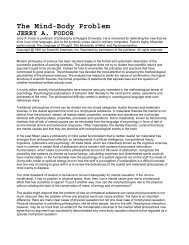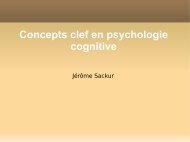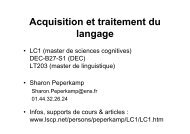From single to multiple deficit models of developmental disorders
From single to multiple deficit models of developmental disorders
From single to multiple deficit models of developmental disorders
Create successful ePaper yourself
Turn your PDF publications into a flip-book with our unique Google optimized e-Paper software.
404 B.F. Penning<strong>to</strong>n / Cognition 101 (2006) 385–413<br />
5. Multiple deWcit model<br />
Similar <strong>to</strong> the complex disease model in medicine (Sing & Reilly, 1993) and the<br />
quantitative genetic model in behavioral genetics (e.g., Plomin, DeFries, McClearn, &<br />
Rutter, 1997), the current model proposes that (1) the etiology <strong>of</strong> complex behavioral<br />
<strong>disorders</strong> is multifac<strong>to</strong>rial and involves the interaction <strong>of</strong> <strong>multiple</strong> risk and protective<br />
fac<strong>to</strong>rs, which can be either genetic or environmental; (2) these risk and protective<br />
fac<strong>to</strong>rs alter the development <strong>of</strong> cognitive functions necessary for normal development,<br />
thus producing the behavioral symp<strong>to</strong>ms that deWne these <strong>disorders</strong>; (3) no <strong>single</strong><br />
etiological fac<strong>to</strong>r is suYcient for a disorder, and few may be necessary; (4)<br />
consequently, comorbidity among complex behavioral <strong>disorders</strong> is <strong>to</strong> be expected<br />
because <strong>of</strong> shared etiologic and cognitive risk fac<strong>to</strong>rs; and (5) the liability distribution<br />
for a given disease is <strong>of</strong>ten continuous and quantitative, rather than being discrete<br />
and categorical, so that the threshold for having the disorder is somewhat<br />
arbitrary. Applying the model <strong>to</strong> the comorbidities considered here (RD+ADHD<br />
and RD+SSD), each individual disorder would each have its own proWle <strong>of</strong> risk fac<strong>to</strong>rs<br />
(both etiologic and cognitive), with some <strong>of</strong> these risk fac<strong>to</strong>rs being shared by<br />
another disorder, resulting in comorbidity.<br />
Fig. 2 illustrates the complex disease model as applied <strong>to</strong> complex behavioral <strong>disorders</strong>.<br />
There are four levels <strong>of</strong> analysis in this diagram: etiologic, neural, cognitive,<br />
and symp<strong>to</strong>m, where clusters <strong>of</strong> symp<strong>to</strong>ms deWne complex behavioral <strong>disorders</strong>. For<br />
Fig. 2. Multiple deWcit model.







